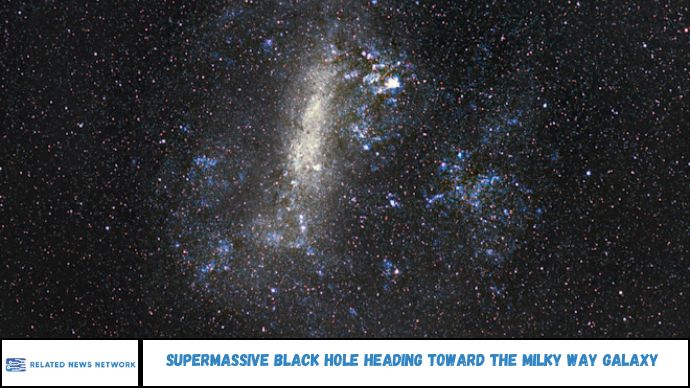Supermassive Black Hole Heading Toward the Milky Way Galaxy But even in the vastness of the universe, some cosmic events demand our attention. One such event? A supermassive black hole hurtling through space—on a collision course with the Milky Way.
Is this a real threat? Could it destroy our galaxy? Or is it simply another spectacular event in the long timeline of the cosmos?
In this article, we’ll break down what this black hole is, where it’s coming from, how scientists discovered it, and what the future holds for our galaxy if it continues on its path. We’ll also explain what makes supermassive black holes so fascinating and terrifying.
Abstract
A supermassive black hole is moving toward the Milky Way Galaxy, raising questions about its potential impact. In this article, we explore its origin, trajectory, estimated timeline, and what this means for the structure and future of our galaxy. Learn how astronomers track such events and what current data tells us about cosmic collisions.
Back in 1971, two British astronomers proposed a bold idea: a supermassive black hole might sit at the heart of our galaxy. Just a few years later, in 1974, astronomers confirmed the presence of this invisible monster—now known as Sagittarius A*—lurking at the Milky Way’s center.
Since that landmark discovery, researchers have found similar giants at the core of nearly every large galaxy. In 2019, the world even got its first direct image of a supermassive black hole, cementing these mysterious entities as central to our understanding of galaxy formation and evolution.
But what about smaller galaxies—specifically dwarf galaxies like the Large Magellanic Cloud (LMC)? Expected to collide with the Milky Way in about 2.4 billion years, the LMC is a prime candidate for exploration. Yet until now, no one was sure whether such small galaxies could host supermassive black holes of their own.
Galactic Evolution: A New Discovery Emerges
That uncertainty may be changing, thanks to a groundbreaking study led by Jiwon Jesse Han and colleagues at the Harvard-Smithsonian Center for Astrophysics. Their research presents compelling evidence that a supermassive black hole could be hiding inside the Large Magellanic Cloud—challenging traditional models of how galaxies grow and evolve.
The Clues Lie in Hypervelocity Stars
To uncover this hidden giant, Han’s team studied a rare type of star known as a hypervelocity star (HVS)—stars moving so fast they can escape the Milky Way’s gravity entirely.
Where Do Hypervelocity Stars Come From?
- Most astronomers believe HVSs are created when a binary star system gets too close to Sagittarius A*.
- One star gets captured by the black hole, while the other is flung away at incredible speeds—millions of miles per hour.
- Over the past 20 years, astronomers have identified 21 of these stars, primarily B-type main-sequence stars, which are hot, bright, and easier to spot in wide-field surveys.
Rewinding the Stars’ Trajectories
Han and his team used new data on the proper motion of these hypervelocity stars—essentially, the direction and speed of their movement through space. By tracing their paths backward, they expected most to lead back to Sagittarius A*.
But the results were surprising.
“We find that half of the unbound hypervelocity stars discovered by the HVS Survey trace back not to the Galactic Center, but to the Large Magellanic Cloud,” Han and co. reported.
The Leo Overdensity: A Celestial Clue
One particular clue stood out: a dense cluster of hypervelocity stars appearing in the constellation Leo, now known as the “Leo Overdensity.” This grouping would be difficult to explain if the stars had originated from the Milky Way.
Possible Explanations:
- A supernova explosion within a binary system could have launched the companion star.
- A stellar slingshot effect involving three or more stars could explain the extreme velocities.
- Or—most intriguingly—a supermassive black hole in the Large Magellanic Cloud may be launching these stars outward, just like Sagittarius A*.
If confirmed, this would be the first evidence of a supermassive black hole in a dwarf galaxy like the LMC—a finding that could reshape how we understand galaxy dynamics, especially as the Milky Way prepares for its eventual collision with this satellite galaxy.
What Is a Supermassive Black Hole?
Before diving into the threat, it helps to understand the nature of supermassive black holes.
- Massive Objects: These black holes contain millions to billions of times the mass of our Sun.
- Found in Galactic Centers: Most large galaxies—including the Milky Way—have one at their core.
- Strong Gravitational Pull: They consume gas, stars, and even light, bending time and space.
Fact: The Milky Way has its own supermassive black hole, Sagittarius A⁎, located at its center and weighing about 4 million solar masses.
The Intergalactic Intruder: What We Know
Astronomers have detected a rogue supermassive black hole, likely ejected from its host galaxy, now racing through space. Here’s what we know so far:
Origin & Detection
- Spotted using the Hubble Space Telescope and confirmed by other observatories.
- Estimated to be 30 million solar masses—7 times the mass of Sagittarius A⁎.
- Possibly flung from a galactic merger involving three black holes, where gravitational interactions hurled one outward.
Speed & Trajectory
- Traveling at over 3 million miles per hour (4.8 million km/h).
- Projected path shows it may eventually enter the Milky Way’s vicinity, though it’s millions of years away.
What Happens If It Reaches the Milky Way?
The idea of two supermassive black holes colliding sounds like a Hollywood disaster movie, but in cosmic terms, it’s more complicated—and far less immediate.
1. No Immediate Danger
- The black hole is hundreds of millions of light-years away.
- It would take billions of years for it to pose any real threat.
2. Possible Galactic Merger
- If it reaches the Milky Way, it could cause a galactic merger—a dramatic but natural event.
- Stars, including our solar system, are unlikely to be directly consumed, thanks to the vast space between celestial bodies.
3. Gravitational Waves
- A collision would release powerful gravitational waves, rippling across the universe.
- Observatories like LIGO and Virgo are already detecting similar events.
NASA Data (2023): The likelihood of black hole mergers increases as the universe ages, but the impact on planetary systems remains minimal in most scenarios.
Why This Matters for Science
This event gives astronomers a front-row seat to understand more about:
- Dark Matter & Dark Energy: Black holes interact with the invisible forces shaping the universe.
- Galaxy Formation: Colliding galaxies and merging black holes influence star creation and distribution.
- Gravity & Space-Time: These extreme objects help test the limits of Einstein’s theory of relativity.
How Are Scientists Tracking It?
Thanks to modern technology, we have multiple tools:
- Hubble & James Webb Space Telescopes: Monitor its movement across deep space.
- Spectroscopy: Measures the velocity and trajectory.
- Simulations: Astrophysicists model possible future interactions using AI and advanced math.
FAQ
1. Is a supermassive black hole really heading toward us?
Yes, one has been detected on a possible path toward the Milky Way, but it’s billions of years away.
2. Could it destroy the Milky Way?
Highly unlikely. While it could eventually merge with our galaxy, individual stars and planets wouldn’t necessarily be harmed.
3. How was it discovered?
Astronomers used space telescopes and observed unusual motion patterns consistent with a rogue black hole.
4. How fast is it moving?
It’s traveling at over 3 million mph (4.8 million km/h), faster than any spacecraft built by humans.
5. Is this event unique?
No—astronomers believe many galaxies have had similar encounters in the past.
6. Will we see effects in our lifetime?
No, this is a long-term cosmic event—billions of years from affecting us.
Conclusion
While the idea of a supermassive black hole heading toward our galaxy might sound alarming, it’s important to put it into perspective. The event is billions of years away, and its impact on our solar system is minimal. But the science we gather today—tracking its path, understanding gravitational behavior, and simulating future interactions—offers us powerful insights into the universe’s fate.







